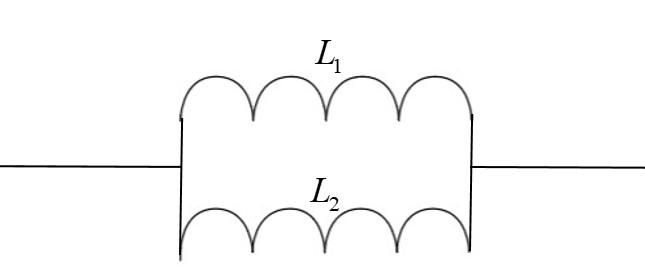
The equivalent inductance of two inductors is 2.4H when connected in parallel 10H when connected in series. The difference between two inductances is (Neglecting mutual inductance):
A. 2H
B. 3H
C. 4H
D. 5H
Answer
514.8k+ views
Hint: Inductance coil is an electrical element of a circuit which stores the electrical energy in the form of magnetic field. Like resistance and capacitor, inductance is also a passive element because it delivers the energy but not on a continuous basis. Inductors are attached in the circuit in series and parallel to each other.
Formula used: In series:

In parallel:

Complete step by step answer:
Let the inductance of the first inductor be
Hence,
And in parallel,
Or
Or
Now, from ①, we have
Or
Or
Or
Now, as
Hence,
Thus,
Hence we can see that the difference between the two inductor values is 2H.
So, the correct answer is “Option A”.
Note: In the question, we are directed to neglect the mutual inductance but practically, we have the mutual inductances between the coils especially if the distances between the inductors is less. Hence if not given to neglect, we have to consider the mutual inductance too. One must be aware that inductors and resistors are similar in the fact that in series, both resistors and inductors are added algebraically to get net value to resistance or inductance and for parallel combination, the reciprocal sum will give the reciprocal of total resistance and inductance of the system.
Formula used: In series:

In parallel:

Complete step by step answer:
Let the inductance of the first inductor be
Hence,
And in parallel,
Or
Or
Now, from ①, we have
Or
Or
Or
Now, as
Hence,
Thus,
Hence we can see that the difference between the two inductor values is 2H.
So, the correct answer is “Option A”.
Note: In the question, we are directed to neglect the mutual inductance but practically, we have the mutual inductances between the coils especially if the distances between the inductors is less. Hence if not given to neglect, we have to consider the mutual inductance too. One must be aware that inductors and resistors are similar in the fact that in series, both resistors and inductors are added algebraically to get net value to resistance or inductance and for parallel combination, the reciprocal sum will give the reciprocal of total resistance and inductance of the system.
Latest Vedantu courses for you
Grade 7 | CBSE | SCHOOL | English
Vedantu 7 CBSE Pro Course - (2025-26)
School Full course for CBSE students
₹45,300 per year
Recently Updated Pages
Master Class 12 Economics: Engaging Questions & Answers for Success

Master Class 12 Maths: Engaging Questions & Answers for Success

Master Class 12 Biology: Engaging Questions & Answers for Success

Master Class 12 Physics: Engaging Questions & Answers for Success

Master Class 12 Business Studies: Engaging Questions & Answers for Success

Master Class 12 English: Engaging Questions & Answers for Success

Trending doubts
Which are the Top 10 Largest Countries of the World?

a Tabulate the differences in the characteristics of class 12 chemistry CBSE

Why is the cell called the structural and functional class 12 biology CBSE

Differentiate between homogeneous and heterogeneous class 12 chemistry CBSE

Derive an expression for electric potential at point class 12 physics CBSE

What is the Full Form of PVC, PET, HDPE, LDPE, PP and PS ?




